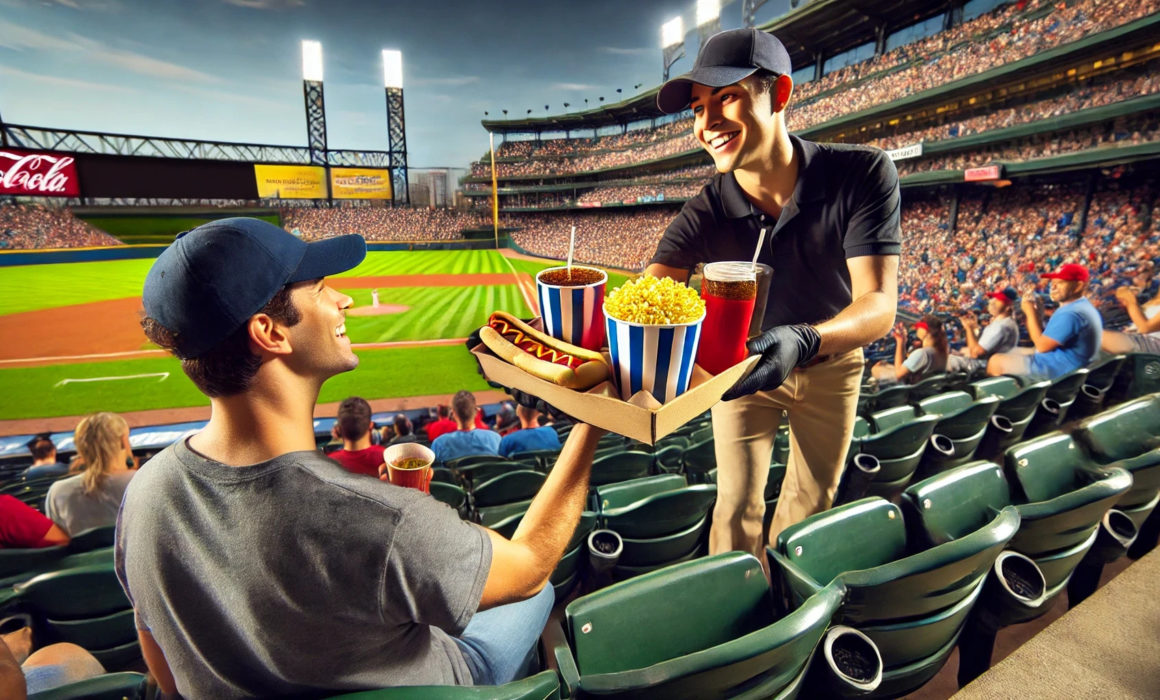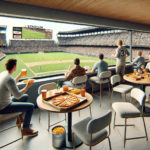At this stage of consideration, prospective buyers of digital ordering solutions are often focused on maximizing order throughput gains, staff optimization, and improving overall fan satisfaction. The topic of in-seat delivery at sports venues is a powerful example of how digital solutions can help repurpose existing resources to create exceptional fan experiences without adding unnecessary burdens to staffing operations. Today, we’ll delve into how the Winnipeg Goldeyes’ adoption of in-seat delivery transformed their stadium environment, repurposed staff more effectively, and ultimately helped fans enjoy their game day to the fullest.
Watch the 2 minute video and hear how the Winnipeg Goldeyes use in-seat delivery in the ballpark. 👇
Expanding in-seat delivery without increasing staff burden
The Winnipeg Goldeyes made a significant leap in guest services when they reported a tenfold increase in in-seat delivery orders. But what caused this surge, and how did they manage it without overwhelming their team? Melissa from the Winnipeg Goldeyes highlighted a key aspect of the transformation: strategic staff repurposing. “We put in place more staff who were able to ensure that fans have that option,” Melissa Schlichting, Food & Beverage Manager of the Winnipeg Goldeyes shared. “In previous years, if we didn’t have enough staff, we might not have offered in-seat delivery at all and just stuck with express pickup. But this year, we wanted to ensure fans had that experience available to them.”
The approach taken by the Goldeyes was not about hiring new team members but about scheduling and allocating existing staff more efficiently to manage in-seat delivery. By strategically repurposing staff from static roles, like fixed concession duties, to more dynamic positions that catered to in-seat orders, they were able to scale the service without adding strain to their existing workforce.
This approach is a prime example of what’s possible when sports venues embrace operational agility. Rather than allowing limited staffing to dictate service offerings, the Winnipeg Goldeyes shifted their focus to what mattered most—fan experience—and adapted accordingly.
Fans prefer in-seat delivery—and they’re willing to pay for it
Another vital takeaway from the Goldeyes’ experience is fan enthusiasm for the in-seat delivery service. The ease of ordering without leaving their seats was a major hit. “Fans see the big line at the concourse and think, ‘I don’t want to wait in those lines. I’ll pay the minimal fee to have it delivered to my seat,” Melissa noted. The convenience factor here cannot be understated—many fans are more than willing to pay extra for a frictionless experience that allows them to remain immersed in the game.
This trend aligns with findings from the Oracle survey that says 76% of fans said in-seat delivery would improve the stadium experience, emphasizing the growing demand for services that prioritize convenience. Melissa also pointed out how this level of service creates a VIP feel, turning an ordinary game into a memorable experience: “People like to be waited on, and they like to feel like VIPs. When someone comes to their seat with their food and drinks, they think, ‘This is crazy!'”
The element of exclusivity and ease elevates the overall stadium experience, encouraging repeat usage and driving higher fan satisfaction. For sports venues considering similar offerings, this is a crucial insight: in-seat delivery isn’t just an added service—it’s a differentiator that can transform the perception of the entire event.
Visibility drives adoption
One of the most effective tools in promoting in-seat delivery is making it highly visible to fans. At the Winnipeg Goldeyes stadium, the visibility of the service was a major driver of its success. “People see others getting their food delivered and think, ‘I want that too.’ It’s all about creating that visual appeal,” Melissa explained. Moving forward, they plan to add stickers on the backs of seats that will have a QR code for easy ordering. “We’re putting it in everyone’s face,” she said, adding that this kind of immediate accessibility will make in-seat delivery even more popular next season.
This direct visibility taps into a natural curiosity and a desire for convenience among fans. Seeing their neighbors in the stands get food and drinks delivered seamlessly to their seats makes the service inherently more attractive.
Repurposing staff to expand service availability
One of the key strategic decisions was not just expanding in-seat delivery but also increasing the locations where this service was available. By deploying staff more flexibly, the Winnipeg Goldeyes were able to include newly developed patio areas in the in-seat delivery zones. “We now have more locations where fans can access the ordering and have food delivered,” Melissa mentioned. This expansion did not require new hires but smarter deployment of current resources, allowing fans to enjoy service wherever they chose to be in the stadium.
The Winnipeg Goldeyes’ approach exemplifies this—rather than limiting their service based on available staff, they leveraged scheduling adjustments and optimized deployment to enhance service areas.
The result: a better experience for fans and staff alike
The implementation of in-seat delivery not only transformed the fan experience but also improved work conditions for the staff. Instead of being confined to concession stands, staff members were now actively part of the game day experience, moving throughout the stadium, engaging with fans, and being more directly involved in the service process. This change resulted in increased job satisfaction among team members, as they were given more varied responsibilities and were able to contribute directly to the elevated fan experience.
Melissa highlighted this shift, explaining, “Having more staff available to do in-seat delivery allowed us to maintain express pickup while giving fans something extra. Staff enjoy being part of making the game day special, and we see the difference it makes in their attitudes.” The result was a mutually beneficial situation—staff felt more valued, and fans received a higher level of service.
Conclusion: scaling fan experience through smart staffing
The Winnipeg Goldeyes’ tenfold increase in in-seat delivery orders is a powerful example of what can happen when sports venues combine digital ordering with smart resource allocation. By repurposing staff effectively, increasing visibility, and providing an in-demand service, they not only improved fan satisfaction but also maximized order throughput.
For sports venues considering digital ordering solutions, the message is clear: in-seat delivery is a crowd-pleaser that doesn’t require an overhaul of current staffing levels. Instead, by focusing on flexibility, visibility, and strategic deployment, it’s possible to provide fans with the kind of VIP experience that keeps them coming back game after game. The Winnipeg Goldeyes have shown that in-seat delivery is not just a service—it’s a strategic advantage that elevates both the fan experience and operational outcomes.
Let’s connect!
Enjoyed the read? Let’s chat about how we can help you with digital food ordering.



